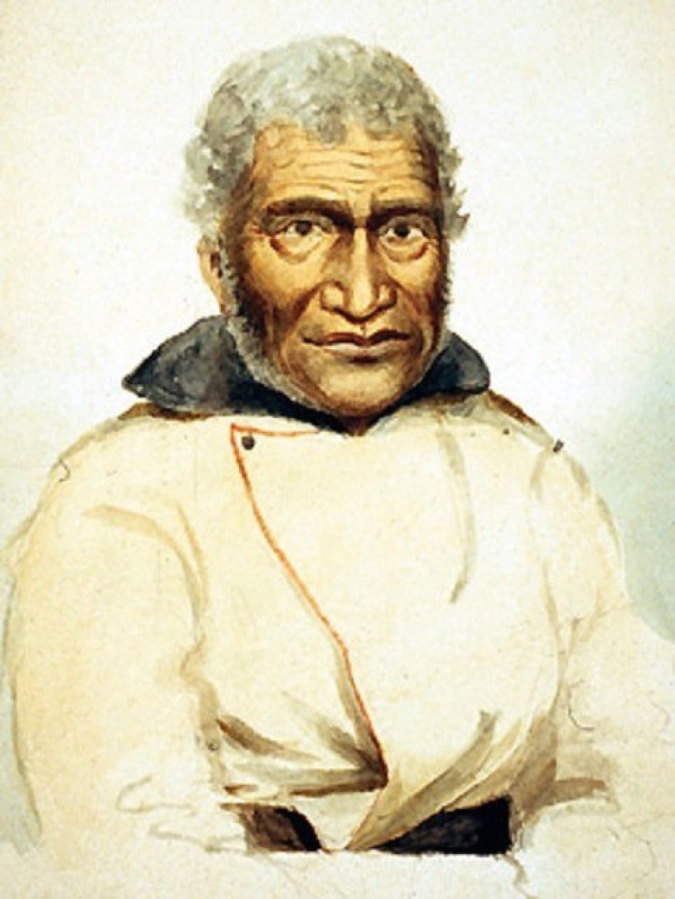At 12, Naukane witnessed the 1779 killing of Capt. James Cook at Kealakekua Bay, Hawaii. The boy was a member of Hawaiian royalty. But, as he watched the English explorer’s death, he never knew he’d become the first Hawaiian to pierce the Pacific Northwest interior. Nor realize he’d spend much of his life as a fur trade employee, traveling twice to England before dying on foreign soil.
John Jacob Astor’s Pacific Fur Company ship, the Tonquin, captained by Jonathan Thorne, arrived at the same bay in 1811 on its way to establish a fur trade outpost on the Columbia River near present-day Astoria. Naukane boarded the ship as a “royal observer” overseeing a dozen island laborers. Unfamiliar with the Hawaiian tongue, the Americans renamed Naukane John Cox (or Coxe) while voyaging to the Columbia.
During the construction of Fort Astoria, Hawaiians slopped pigs and tended gardens. When mapmaker David Thompson of the North West Company rested at the fort for a week in July 1811, he met Naukane and respected the Hawaiian. Clerk Alexander Ross wrote that the Pacific Fur Company gave Thompson “one of our Sandwich Islanders, named Coxe,” adding that Thompson found the man “a prodigy of wit and humor.” Thompson and Naukane paddled a canoe to reach Fort William near Lake Superior.
They reached Fort William as the War of 1812 broke out. The North West Company chose to seize Fort Astoria for England. Naukane was among the party capturing the fort. Because he knew about the Columbia River bar crossing, the North West Company sent him to England to help outfit a ship. After the war, the company bought Fort Astoria, renaming it Fort George.
In 1814, Naukane returned to Hawaii, rejoining the royal court. In 1824, he sailed to England with Kamehameha II and other high-ranking people. Within a few weeks, Kamehameha died from measles. Returning with the bodies, Naukane and those unaffected by measles were suspected of ill will, and rumors spread of financial fraud. It’s presumed Naukane returned to the fur trade to escape this mistrust.
Given that Naukane returned to the fur business in 1824 — after an 1821 merger of fur trade companies — he became a Hudson’s Bay Company employee. The following year, Hawaiian employees’ theft of blankets and beaver pelts implicated Naukane, who maintained his innocence.
When the Hudson’s Bay Company ordered Chief Factor John McLaughlin to create a farm and send produce to England, Naukane labored at Fort Vancouver as a “middleman” aboard Hudson’s Bay Company vessels and worked as a swineherd also. Hog farming wasn’t easy. During its first year, many pigs died after eating noxious weeds.
A clerk at the fort, Thomas Lowe, recorded Naukane’s death in 1850 saying, “Old Coxe, a Sandwich Islander, who has been a long time in this Country in the Company’s employ, died here yesterday afternoon.”
Until his death at 83, Naukane lived in the employee settlement called Kanaka Village, although its Hawaiian population was small. Once, the flat plain along the Land Sky Bridge to Fifth Street was called Cox Plain in his honor. Today anyone crossing the bridge struggles to imagine that place without Pearson Field, the railroad and state Highway 14.
Martin Middlewood is editor of the Clark County Historical Society Annual. Reach him at ClarkCoHist@gmail.com.



